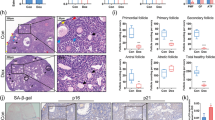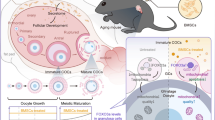Abstract
This study evaluated the remote ischemic preconditioning (R-IPC) early and late repercussion on fresh ovarian transplants, aiming to assess a probable protective effect in ovarian follicular pool. Sixty Wistar EPM-1 rats were used, divided in 2 study groups: ovarian transplantation (Tx) and Tx + R-IPC, submitted to ovary transplant with or without R-IPC, respectively. These groups were subdivided according to the date for euthanasia: 4th, 7th, 14th, 21st, and 30th days of the postoperatory period. Morphology, morphometry, neoangiogenesis (vascular endothelial growth factor [VEGF]), proliferative activity (Ki-67), and apoptosis (cleaved caspase-3) were evaluated. Remote ischemic preconditioning was performed in the common iliac artery. Fresh autologous ovarian tissue was implanted integrally in the retroperitoneum. All animals showed resumption of estrous phase after ovary transplantation. Remote ischemic preconditioning attenuated the lesions progressively from the 7th day, with greater number of the immature follicles (14 days, P < .05), but didn’t affect mature follicles and corpora lutea (P > .05). Immunohistochemical analyzes, taken as a whole, show that R-IPC benefic effect is more evident in the later periods of evaluation, when a greater proliferative activity (14, 21, and 30 days, P < .05) and lesser cell apoptotic activity (21 and 30 days, P < .05). The VEGF expression was similar in all times (P > .05). Remote ischemic preconditioning could have a benefic effect in the progressive evaluation of freshly grafted ovarian, especially on the latest phases of the posttransplant period. The 14th day was a landmark in the recuperation of the graft. Further investigations are necessary to determine the role of R-IPC in this scenario and its effect in frozen-thawed ovarian tissue.
Similar content being viewed by others
References
Oktay K, Oktem O. Ovarian cryopreservation and transplantation for fertility preservation for medical indications: report of an ongoing experience. Fertil Steril. 2010;93(3):762–768.
Donnez J, Dolmans MM, Pellicer A, et al. Restoration of ovarian activity and pregnancy after transplantation of cryopreserved ovarian tissue: a review of 60 cases of reimplantation. Fertil Steril. 2013;99(6):1503–1513.
Loren AW, Mangu PB, Beck LN, et al; American Society of Clinical Oncology. Fertility preservation for patients with cancer: American Society of Clinical Oncology clinical practice guideline update. J Clin Oncol. 2013;31(19):2500–2510.
Sonmezer M, Oktay K. Orthotopic and heterotopic ovarian tissue transplantation. Best Pract Res Clin Obstet Gynaecol. 2010;24(1): 113–126.
Kolp LA, Hubayter Z. Autotransplantation of cryopreserved ovarian tissue: a procedure with promise, risks, and a need for a registry. Fertil Steril. 2011;95(6):1879–1886.
Bedaiwy MA, El-Nashar SA, El Saman AM, et al. Reproductive outcome after transplantation of ovarian tissue: a systematic review. Hum Reprod. 2008;23(12):2709–2717.
Nugent D, Newton H, Gallivan L, Gosden RG. Protective effect of vitamin E on ischaemia-reperfusion injury in ovarian grafts. J Reprod Fertil. 1998;114(2):341–346.
Israely T, Nevo N, Harmelin A, Neeman M, Tsafriri A. Reducing ischaemic damage in rodent ovarian xenografts transplanted into granulation tissue. Hum Reprod. 2006;21(6):1368–1379.
Oktay K, Buyuk E. Ovarian transplantation in humans: indications, techniques and the risk of reseeding cancer. Eur J Obstet Gynecol Reprod Biol. 2004;113(suppl 1):s45–s47.
Donnez J, Squifflet J, Dolmans MM, Martinez-Madrid B, Jadoul P, Langendonckt A. Orthotopic transplantation of fresh ovarian cortex: a report of two cases. Fertil Steril. 2005;84(4): 1018.e1–3.
Sanchéz M, Alamá P, Gadea B, Soares SR, Simón C, Pellicer A. Fresh human orthotopic ovarian transplantation: long-term results. Hum Reprod. 2007;22(3):786–791.
Dissen GA, Lara HE, Fahrenbach WH, Costa ME, Ojeda SR. Immature rat ovaries become revascularized rapidly after auto-transplantation and show a gonadotropin-dependent increase in angiogenic factor gene expression. Endocrinology. 1994;134(3): 1146–1154.
Liu J, Elst J, Broecke R, Dhont M. Early massive follicle loss and apoptosis in heterotopically grafted newborn mouse ovaries. Hum Reprod. 2002;17(3):605–611.
Risvanli A, Timurkan H, Akpolat N, Gulacti I, Ulakoglu E. A study of ovarian autotransplantation without vascular a pedicle in rats. J Assist Reprod Genet. 2006;23(11–12):401–406.
Oktay K, Newton H, Gosden RG. Transplantation of cryopreserved human ovarian tissue results in follicle growth initiation in SCID mice. Fertil Steril. 2000;73(3):599–603.
Yang HY, Cox SL, Jenkin G, Findlay J, Trouson A, Shaw J. Graft site and gonadotrophin stimulation influences the number and quality of oocytes from murine ovarian tissue grafts. Reproduction. 2006;131(5):851–859.
Kim SS, Yang HW, Kang HG, et al. Quantitative assessment of ischemic tissue damage in ovarian cortical tissue with or without antioxidant (ascorbic acid) treatment. Fertil Steril. 2004;82(3): 679–685.
Konstantinov IE, Arab S, Li J, et al. The remote ischemic preconditioning stimulus modifies gene expression in mouse myocardium. J Thorac Cardiovasc Surg. 2005;130(5):1326–1332.
Murry CE, Jennings RB, Reimer KA. Preconditioning with ischemia: a delay of lethal cell injury in ischemic myocardium. Circulation. 1986;74(5):1124–1136.
Ambros JT, Herrero-Fresneda I, Borau OG, Boira JM. Ischemic preconditioning in solid organ transplantation: from experimental to clinics. Transpl Int. 2007;20(3):219–229.
Pasupathy S, Homer-Vanniasinkam S. Ischaemic preconditioning protects against ischaemia/reperfusion injury: emerging concepts. Eur J Vasc Endovasc Surg. 2005;29(2):106–115.
Przyklenk K, Bauer B, Ovize M, Kloner RA, Whittaker P. Regional ischemic ‘preconditioning’ protects remote virgin myocardium from subsequent sustained coronary occlusion. Circulation. 1993;87(3):893–899.
Liauw SK, Rubin BB, Lindsay TF, Romaschin AD, Walker PM. Sequential ischemia/reperfusion results in contralateral skeletal muscle salvage. Am J Physiol. 1996;270(4 pt 2): h1407–h1413.
Kanoria S, Jalan R, Seifalian AM, Williams R, Davidson BR. Protocols and mechanisms for remote ischemic preconditioning: a novel method for reducing ischemia reperfusion injury. Transplantation. 2007;84(4):445–458.
Loukogeorgakis SP, Panagiotidou AT, Broadhead MW, Donald A, Deanfield JE, MacAllister RJ. Remote ischemic preconditioning provides early and late protection against endothelial ischemia-reperfusion injury in humans: role of the autonomic nervous system. J Am Coll Cardiol. 2005;46(3):450–456.
Lee W-Y, Lee S-M. Ischemic preconditioning protects post-ischemic oxidative damage to mitochondria in rat liver. Shock. 2005;24(4):370–375.
Kimura M, Ueda K, Goto C, et al. Repetition of ischemic preconditioning augments endothelium-dependent vasodilation in humans: role of endothelium-derived nitric oxide and endothelial progenitor cells. Arterioscler Thromb Vasc Biol. 2007;27(6): 1403–1410.
Damous LL, Silva SM, Simões RS, et al. Remote ischemic preconditioning on neovascularization and follicle viability on ovary autotransplantation in rats. Transplant Proc. 2008; 40(3):861–864.
Yang H, Lee HH, Lee HC, Ko DS, Kim SS. Assessment of vascular endothelial growth factor expression and apoptosis in the ovarian graft: can exogenous gonadotropin promote angiogenesis after ovarian transplantation? Fertil Steril. 2008;90(4 suppl): 1550–1558.
D’Acampora AJ, Tramonte R, Manoel FS, et al. Análise histológica da viabilidade do transplante autólogo de hemi-ovário em retroperitônio de ratos. Acta Cir Bras. 2004;19(4):318–326.
Barros FS, de Oliveira RM, Alves FM, Sampaio M, Geber S. Successful ovarian autotransplant with no vascular reanastomosis in rats. Transplantation. 2008;86(11):1628–1630.
Nisolle M, Casanas-Roux F, Qu J, Motta P, Donnez J. Histologic and ultrastructural evaluation of fresh and frozen-thawed human ovarian xenografts in nude mice. Fertil Steril. 2000;74(1): 122–129.
Schubert B, Canis M, Darcha C, Artonne C, Smitz J, Grizard G. Follicular growth and estradiol follow-up after subcutaneous xenografting of fresh and cryopreserved human ovarian tissue. Fertil Steril. 2008;89(6):1787–1794.
Ceschin AP, Biondo-Simões MLP, Thomaz BAC, Totsugui J. Avaliação hormonal indireta e estudo da preservação folicular em tecido ovariano autólogo transplantado para região inguinal em ratos. Acta Cir Bras. 2004;19(1):27–30.
Damous LL, Silva SM, Carbonel AP, Simões RS, Simões MJ, Montero EF. Effect of remote ischemic preconditioning on rat estradiol serum levels and follicular development after ovarian transplantation. Transplant Proc. 2009;41(3):830–833.
Newton H, Aubard Y, Rutherford A, Sharma V, Gosden R. Low temperature storage and grafting of human ovarian tissue. Hum Reprod. 1996;11(7):1487–1491.
Baird DT, Webb R, Campbell BK, Harkness LM, Gosden RG. Long-term ovarian function in sheep after ovariectomy and transplantation of autografts stored at -196 C. Endocrinology. 1999;140(1):462–471.
Sahinkanat T, Ozkan KU, Tolun FI, Ciralik H, Imrek SS. The protective effect of ischemic preconditioning on rat testis. Reprod Biol Endocrinol. 2007;5:47.
Hausenloy DJ, Yellon DM. Remote ischemic preconditioning: Underlying mechanisms and clinical application. Cardiovasc Res. 2008;79(3):377–386.
Author information
Authors and Affiliations
Corresponding author
Rights and permissions
About this article
Cite this article
Damous, L.L., Silva, S.M.d., Carbonel, A.A.F. et al. Progressive Evaluation of Apoptosis, Proliferation, and Angiogenesis in Fresh Rat Ovarian Autografts Under Remote Ischemic Preconditioning. Reprod. Sci. 23, 803–811 (2016). https://doi.org/10.1177/1933719115620493
Published:
Issue Date:
DOI: https://doi.org/10.1177/1933719115620493




